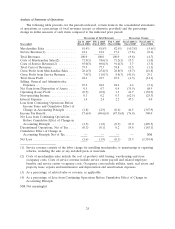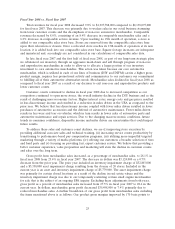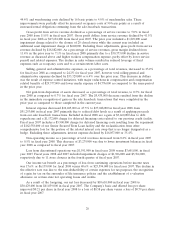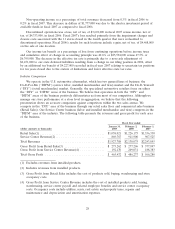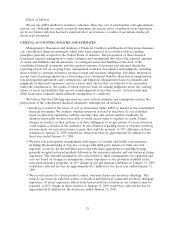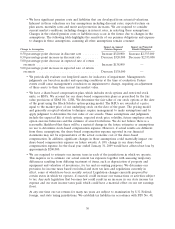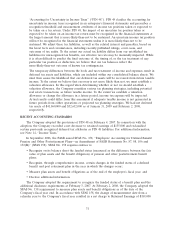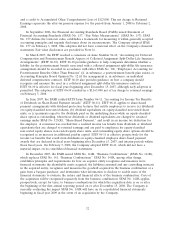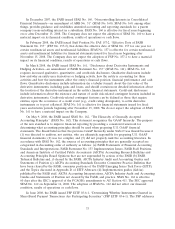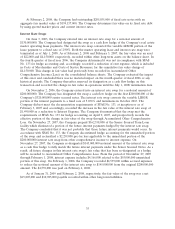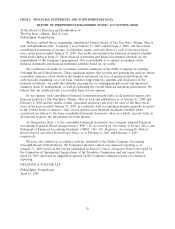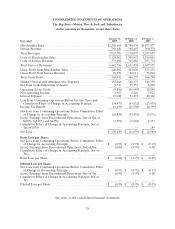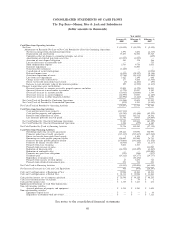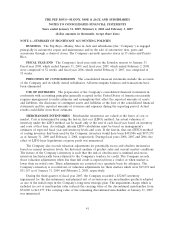Pep Boys 2008 Annual Report Download - page 96
Download and view the complete annual report
Please find page 96 of the 2008 Pep Boys annual report below. You can navigate through the pages in the report by either clicking on the pages listed below, or by using the keyword search tool below to find specific information within the annual report.and a credit to Accumulated Other Comprehensive Loss of $123,000. This net charge to Retained
Earnings represents the after-tax pension expense for the period from January 1, 2008 to February 2,
2008.
In September 2006, the Financial Accounting Standards Board (FASB) issued Statement of
Financial Accounting Standards (SFAS) No. 157, ‘‘Fair Value Measurements’’ (SFAS No. 157). SFAS
No. 157 defines the term fair value, establishes a framework for measuring it within generally accepted
accounting principles and expands disclosures about its measurements. The Company adopted SFAS
No. 157 on February 3, 2008. This adoption did not have a material effect on the Company’s financial
statements. Fair value disclosures are provided in Note 16.
In March 2007, the EITF reached a consensus on Issue Number 06-10, ‘‘Accounting for Deferred
Compensation and Postretirement Benefit Aspects of Collateral Assignment Split-Dollar Life Insurance
Arrangements’’ (EITF 06-10). EITF 06-10 provides guidance to help companies determine whether a
liability for the postretirement benefit associated with a collateral assignment split-dollar life insurance
arrangement should be recorded in accordance with either SFAS No. 106, ‘‘Employers’ Accounting for
Postretirement Benefits Other Than Pensions’’ (if, in substance, a postretirement benefit plan exists), or
Accounting Principles Board Opinion No. 12 (if the arrangement is, in substance, an individual
deferred compensation contract). EITF 06-10 also provides guidance on how a company should
recognize and measure the asset in a collateral assignment split-dollar life insurance contract.
EITF 06-10 is effective for fiscal years beginning after December 15, 2007, although early adoption is
permitted. The adoption of EITF 06-10 resulted in a $1,165,000 net of tax charge to retained earnings
on February 3, 2008.
In June 2007, the FASB ratified EITF Issue Number 06-11, ‘‘Accounting for Income Tax Benefits
of Dividends on Share-Based Payment Awards’’ (EITF 06-11). EITF 06-11 applies to share-based
payment arrangements with dividend protection features that entitle employees to receive (a) dividends
on equity-classified non-vested shares, (b) dividend equivalents on equity-classified non-vested share
units, or (c) payments equal to the dividends paid on the underlying shares while an equity-classified
share option is outstanding, when those dividends or dividend equivalents are charged to retained
earnings under SFAS No. 123(R), ‘‘Share-Based Payment,’’ and result in an income tax deduction for
the employer. A consensus was reached that a realized income tax benefit from dividends or dividend
equivalents that are charged to retained earnings and are paid to employees for equity-classified
non-vested equity shares, non-vested equity share units, and outstanding equity share options should be
recognized as an increase in additional paid-in capital. EITF 06-11 is effective prospectively for the
income tax benefits that result from dividends on equity-classified employee share-based payment
awards that are declared in fiscal years beginning after December 15, 2007, and interim periods within
those fiscal years. On February 3, 2008, the Company adopted EITF 06-11, which did not have a
material impact on its consolidated financial statements.
In December 2007, the FASB issued SFAS No. 141R, ‘‘Business Combinations’’ (SFAS No. 141R),
which replaces SFAS No. 141, ‘‘Business Combinations.’’ SFAS No. 141R, among other things,
establishes principles and requirements for how an acquirer entity recognizes and measures in its
financial statements the identifiable assets acquired, the liabilities assumed and any controlling interests
in the acquired entity; recognizes and measures the goodwill acquired in the business combination or a
gain from a bargain purchase; and determines what information to disclose to enable users of the
financial statements to evaluate the nature and financial effects of the business combination. Costs of
the acquisition will be recognized separately from the business combination. SFAS No. 141R applies
prospectively, except for taxes, to business combinations for which the acquisition date is on or after
the beginning of the first annual reporting period on or after December 15, 2008. The Company is
currently evaluating the impact SFAS No. 141R will have on its consolidated financial statements
beginning in fiscal year 2009 in the event of an acquisition by the Company.
32




